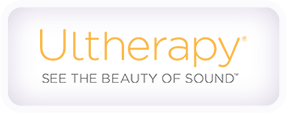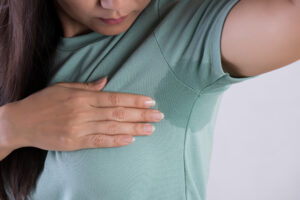 Hyperhidrosis, also known as excessive sweating, is when you sweat too much in situations not related to heat or exercise. The sweating can affect all areas of your body, or be concentrated in specific areas such as the armpits, palms and feet. This is often embarrassing and distressing especially in social situations. While excessive sweating does not pose a risk to your health, it can affect your quality of life. Luckily, there are treatments for hyperhidrosis that can solve the issue.
Hyperhidrosis, also known as excessive sweating, is when you sweat too much in situations not related to heat or exercise. The sweating can affect all areas of your body, or be concentrated in specific areas such as the armpits, palms and feet. This is often embarrassing and distressing especially in social situations. While excessive sweating does not pose a risk to your health, it can affect your quality of life. Luckily, there are treatments for hyperhidrosis that can solve the issue.
Causes:
Hyperhidrosis has two forms: primary and secondary. Primary hyperhidrosis has no medical cause and often runs in families. The excessive sweating is due to overactive sweat glands in the palms, soles and underarms. If the sweating is due to an underlying medical condition or taking certain medications, we refer to it as secondary hyperhidrosis. Addressing and treating the medical condition can resolve the sweating issues in some cases. Health conditions that can cause excessive sweating include diabetes, leukemia and menopause.
Complications can arise from hyperhidrosis: sweating too much can lead to skin infections. If left untreated, the condition is likely to persist through the person’s life, which can affect mental health and social well-being. That is why many people turn to treatments to eliminate or reduce the issue.
Treatments:
Treatment for hyperhidrosis starts with a professional consultation with a doctor. The doctor will conduct a physical exam, and ask specific questions to understand the cause of excessive sweating. Sometimes medical testing may be necessary, as well as tests to detect an underlying condition. Treatment then can include anti-perspirants, prescription cloth wipes, and Botox injections. At our medical center, we have excellent results with using Botox to treat excessive sweating. If this issue is a concern for you, contact us to explore your options for treatment.
Read our previous blog post on skin pigmentation here.
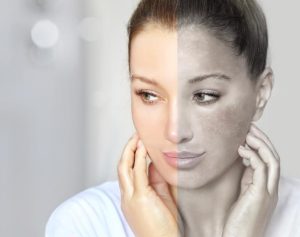 Hyperpigmentation is when certain areas of the skin appear darker than others. These dark patches are not painful or itchy, but they can make a person self-conscious about their appearance. It is caused by an increase in melanin, which is a natural pigment that gives our skin its color. Many things can lead to hyperpigmentation, such as sun damage, genetics, and hormonal changes. Medical diseases and certain medications can also lead to this skin condition. It is common in types III-VI of the Fitzpatrick skin classification. Lifestyle changes and treatments are possible solutions for excessive pigmentation.
Hyperpigmentation is when certain areas of the skin appear darker than others. These dark patches are not painful or itchy, but they can make a person self-conscious about their appearance. It is caused by an increase in melanin, which is a natural pigment that gives our skin its color. Many things can lead to hyperpigmentation, such as sun damage, genetics, and hormonal changes. Medical diseases and certain medications can also lead to this skin condition. It is common in types III-VI of the Fitzpatrick skin classification. Lifestyle changes and treatments are possible solutions for excessive pigmentation.
Types of hyperpigmentation:
There are three main types: age spots, melasma, and post-inflammatory hyperpigmentation. Age spots appear after lengthy sun exposure, and look like brown, tan or black patches. Melasma affects pregnant women, women on birth control pills, as well as menopausal women. As for post-inflammatory hyperpigmentation, these darkened patches appear on the skin after a condition such as acne or eczema. This is the most common type in the Middle East.
Melanin in your skin absorbs the energy of harmful ultraviolet rays when exposed to the sun. To protect yourself when out in the sun, make sure to wear a broad-spectrum sunscreen.
Treatments for hyperpigmentation:
Topical creams can be used for treatment: these creams include ingredients such as hydroquinone, vitamin C, kojic acid, retinoids, azelaic acid, and more. It usually takes 3 – 6 months of consistent use to restore skin color. Since hyperpigmentation is a challenging problem, it is essential that the patient is diligent in using the product. Cosmetic procedures are also an option, such as laser skin resurfacing, microdermabrasion and chemical peels. These procedures gently remove the top layer of skin which has the dark spots. After recovery, your dark spots will be lightened and the skin tone will be more balanced.
Consult your doctor to find out what treatments are available. Although this skin condition is harmless, many of us find it annoying to have an uneven skin tone. Luckily, there are effective options for treating and restoring your skin.
Read our previous blog post on acne scars here.
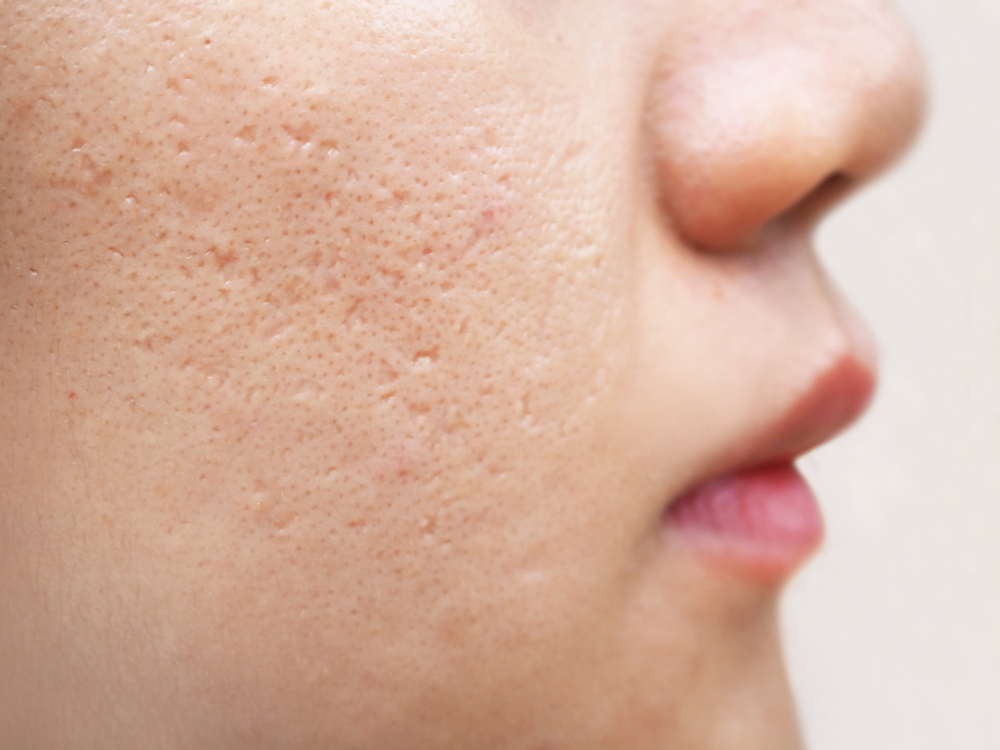
Acne breakouts are annoying, but the scars left behind can be even more frustrating to deal with. Luckily, there are several treatments that can restore your appearance. These include chemical peels and surgical excision. Less invasive treatments such as DermaPen, SilkPeel, fillers and laser are also methods of treating acne scars. Before starting a treatment plan for scarring, it is important to first eliminate the acne. That is because acne breakouts can lead to new scars that must then be treated. Treating acne early is the best way to prevent and limit acne scars.
About acne and acne scars:
What causes acne? When tiny holes in the skin called hair follicles are blocked, acne is created. Whiteheads are formed when the plugged hair follicle is near the surface of the skin. Alternatively, blackheads are formed when the plugged hair follicle is open to the skin. The difference between them is that whiteheads are closed pores while blackheads remain open. These acne bumps usually appear on the face, but can also appear on the back, chest, neck and arms. As for acne scars, these happen when a breakout penetrates the skin deeply and damages the tissue underneath.
Treatments:
Before acne scars are treated, your doctor will determine what type they are, since certain types respond better to certain treatments. There are several options to treat acne scarring: laser resurfacing, chemical peels and surgical excision (which might be used if the scarring is deep). Otherwise, two microneedling options are DermaPen or radiofrequency (RF) microneedling. DermaPen is a microneedling device that tightens and rejuvenates the skin. It induces the production of collagen and elastin, which diminishes skin blemishes such as acne scars. On the other hand, RF micro-needling delivers heat stimulation for collagen and usually goes deeper in the tissue.
SilkPeel (now called Dermaglow) and HydraFacial are other options to consider. SilkPeel is a wet microdermabrasion technique that exfoliates the skin and delivers serums below the surface. These serums target specific skin conditions, such as acne scarring and acne in general. It is ideal for patients with more sensitive skin that can’t withstand harsh chemicals and devices. Another choice is laser skin resurfacing, a method where the skin is removed layer by layer with precision. The new skin cells that are produced are tighter and have a more youthful appearance. You can also consider fillers, whether hyaluronic acid fillers or fat grafting. Please contact us to discuss the treatments available.
Read our blog post about the benefits of SilkPeel here.
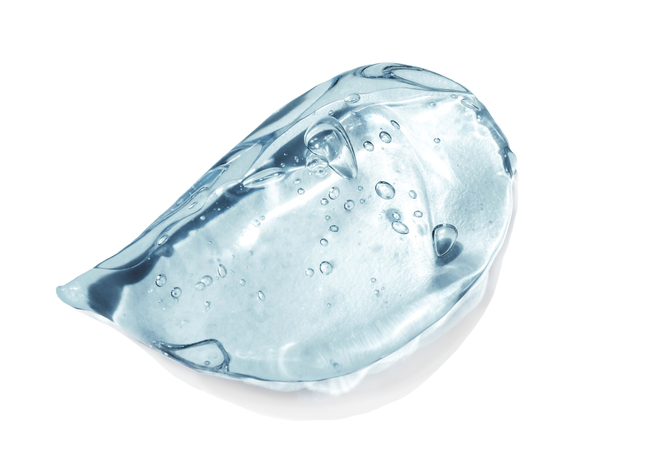 Hyaluronic acid (HA) is a substance naturally produced by the body that helps keep the skin hydrated and supple. Its main function is to retain water so that skin stays moist. Like collagen and elastin, the amount in our body decreases as we age. It can be applied to the body through topical creams as well as through injections. Injections tend to have better results due to higher penetration while leads to better absorption. Skin boosters are micro-injections of hyaluronic acid in the skin. HA does not enter skin cells, but stays within the epidermis between cells. The HA that is injected is synthetic (not produced by humans), and is tolerated well by the body with few side effects and reactions.
Hyaluronic acid (HA) is a substance naturally produced by the body that helps keep the skin hydrated and supple. Its main function is to retain water so that skin stays moist. Like collagen and elastin, the amount in our body decreases as we age. It can be applied to the body through topical creams as well as through injections. Injections tend to have better results due to higher penetration while leads to better absorption. Skin boosters are micro-injections of hyaluronic acid in the skin. HA does not enter skin cells, but stays within the epidermis between cells. The HA that is injected is synthetic (not produced by humans), and is tolerated well by the body with few side effects and reactions.
Difference between skin boosters and fillers:
Both skin boosters and fillers contain HA, although there are differences between them. Fillers are used to lift, enhance and restore a defect in the body. Skin boosters, also known as hydrating fillers, are used to improve skin hydration. Fillers are injected underneath the skin’s surface, while skin boosters are injected into the skin. Fillers also tend to have high viscosity while skin boosters have low viscosity.
5 benefits of hyaluronic acid:
Promotes healthier skin: HA makes skin supple and less dry, while also reducing fine lines and wrinkles. It is essential for maintaining a bright and healthy complexion.
Hydrates the skin: HA holds up to 1000x times its weight in water and helps regulate water content and transport in the skin. That is why it is important for skin hydration.
Improves skin texture: another benefit of HA is that it reduces the roughness of the skin and increases skin elasticity. Smoothing the skin helps with maintaining a youthful appearance.
Fights aging: around 50% of the body’s HA is in the skin. When this amount reduces as a person gets older, wrinkles and fine lines can form. Applying and injecting HA can help restore optimal levels in the skin to counter the aging process.
Supplement to other treatments: HA pairs well with treatments such as DermaPen and chemical or mechanical peels. Please consult with your doctor to determine which treatments are suitable for you.
Read our blog post about the benefits of Vitamin A for skincare here.
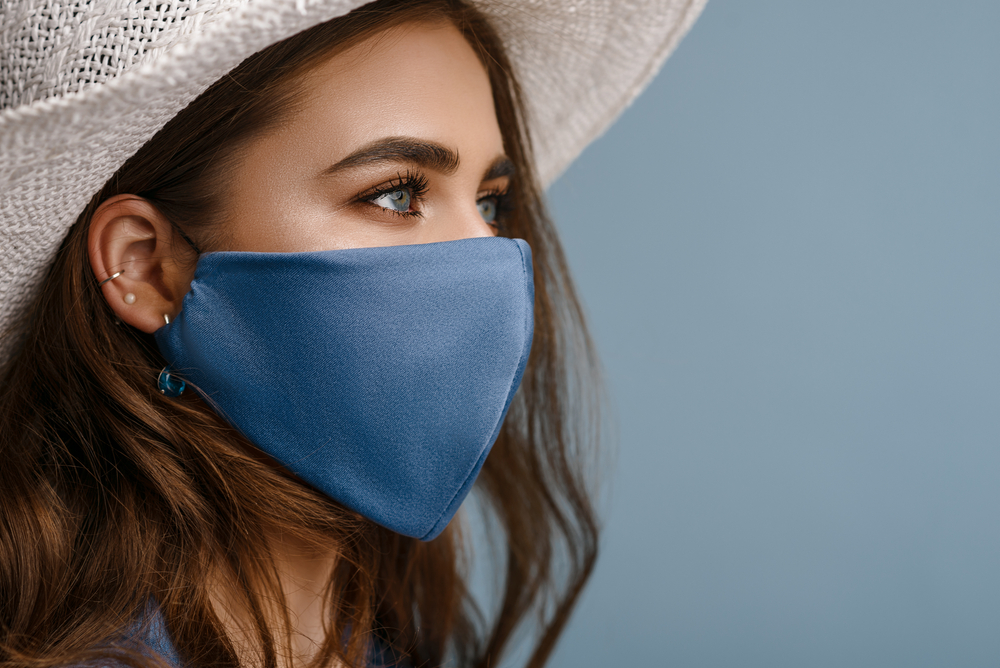 The coronavirus pandemic is having a huge impact on every industry and changing the aesthetic procedures that are most requested. The lockdowns have led to a rise in remote work, and along with it increased activity on video conferencing software. Now that we are spending more time on Zoom and Skype, we are concerned with our appearance on live video. Research has shown an uptake in facial and eye-related surgeries, as well as a trend towards natural beauty for the looks desired.
The coronavirus pandemic is having a huge impact on every industry and changing the aesthetic procedures that are most requested. The lockdowns have led to a rise in remote work, and along with it increased activity on video conferencing software. Now that we are spending more time on Zoom and Skype, we are concerned with our appearance on live video. Research has shown an uptake in facial and eye-related surgeries, as well as a trend towards natural beauty for the looks desired.
Masks draw attention to the eyes, so procedures such as eye lift and brow lift are more popular. Clear skin and brightness around the eyes are ideal ways to look healthy while wearing masks. It’s harder to communicate emotion with a mask on, so we need to use our eyes for expression. Botox trends have shifted to a “bright-eye” look, where the injections relax facial muscles and soften wrinkles around the eyes. This makes them appear more rested and appealing. Whereas before we worried about how we look in Instagram photos, now we care about our appearance in live video. This favors injectables with a natural aesthetic that allows fluid motion in the face while we chat and laugh.
The pandemic is making us more concerned about personal health and wellness, and that is changing our priorities. We want to project an image of health, and look in the mirror and sense that we are healthy. Some people are opting for non-surgical procedures due to fear over contracting COVID-19 with the aesthetic surgeries, although those are still popular. The lockdowns also mean that they can recover comfortably at home without having to go to the workplace. Due to an increase of stress and anxiety during the pandemic, there are also people seeking procedures for psychological relief. They feel happier and more stable when they receive them. Facial aesthetics are now the focus, whether we are out in the world or presenting ourselves on video. A natural look has made a comeback as COVID-19 changes the world and the aesthetic industry along with it.
 Hyperhidrosis, also known as excessive sweating, is when you sweat too much in situations not related to heat or exercise. The sweating can affect all areas of your body, or be concentrated in specific areas such as the armpits, palms and feet. This is often embarrassing and distressing especially in social situations. While excessive sweating does not pose a risk to your health, it can affect your quality of life. Luckily, there are treatments for hyperhidrosis that can solve the issue.
Hyperhidrosis, also known as excessive sweating, is when you sweat too much in situations not related to heat or exercise. The sweating can affect all areas of your body, or be concentrated in specific areas such as the armpits, palms and feet. This is often embarrassing and distressing especially in social situations. While excessive sweating does not pose a risk to your health, it can affect your quality of life. Luckily, there are treatments for hyperhidrosis that can solve the issue.

 Hyperpigmentation is when certain areas of the skin appear
Hyperpigmentation is when certain areas of the skin appear 
 Hyaluronic acid (HA) is a substance naturally produced by the body that helps keep the skin
Hyaluronic acid (HA) is a substance naturally produced by the body that helps keep the skin  The coronavirus pandemic is having a huge impact on every industry and changing the aesthetic procedures that are most requested. The lockdowns have led to a rise in remote work, and along with it increased activity on video conferencing software. Now that we are spending more time on Zoom and Skype, we are concerned with our appearance on
The coronavirus pandemic is having a huge impact on every industry and changing the aesthetic procedures that are most requested. The lockdowns have led to a rise in remote work, and along with it increased activity on video conferencing software. Now that we are spending more time on Zoom and Skype, we are concerned with our appearance on 


